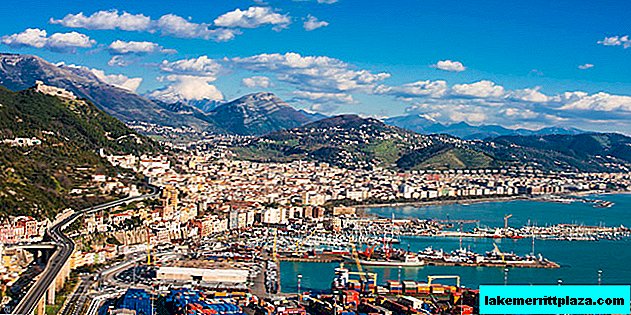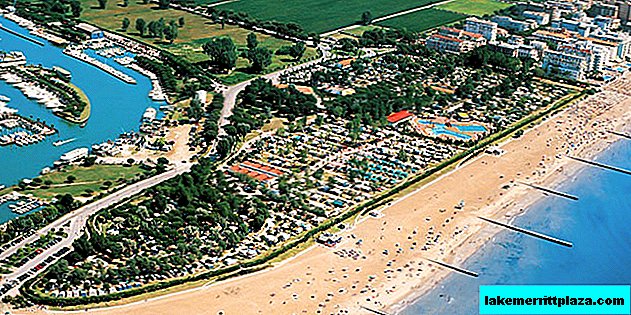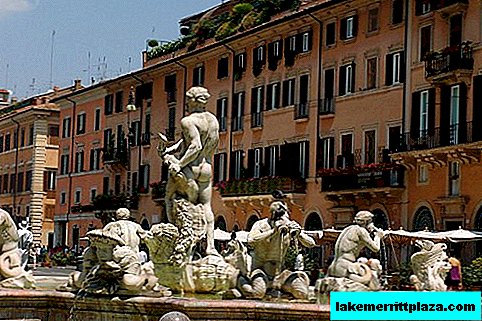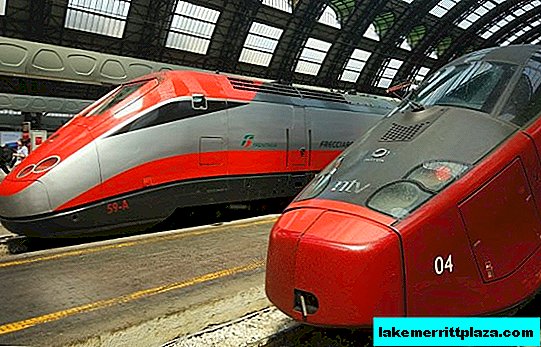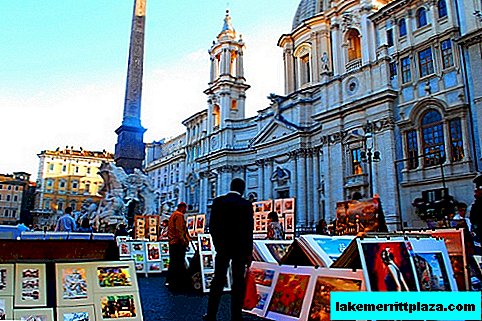Parma, although a small town, is world famous: who does not know about parmesan cheese, prosciutto ham, sausages and other culinary products? Glorified the city and attractions. Here is one of the oldest universities in Europe, the basilica, on the wall of which the face of the Mother of God once appeared, as well as the palace where Marie-Louise lived and rules the city, the last wife of Napoleon Bonaparte.
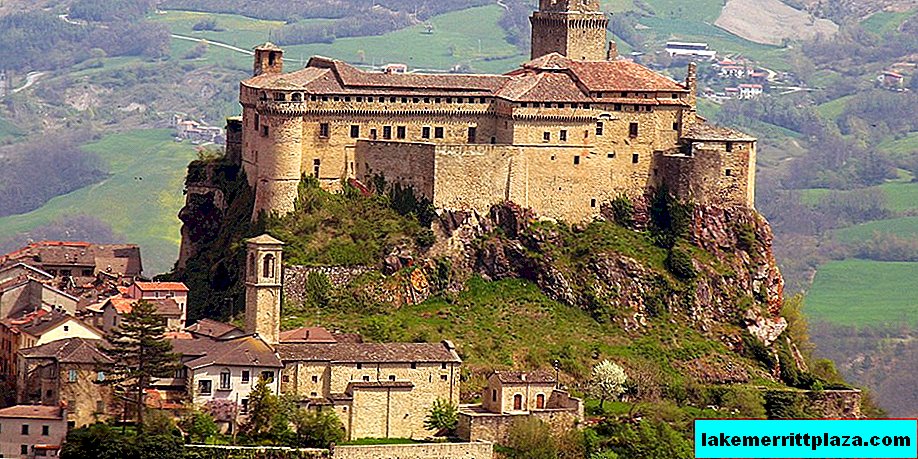
Where is
Parma is located 366 km north of Rome in the Emilia-Romagna region, and is one of its administrative centers. On a geographical map, the city can be found at the following coordinates: 44 ° 48 'north latitude, 10 ° 20' east longitude.

The first mention of Parma dates back to 183 BC, when it became a Roman colony and an important trading center.
The Parma River flows through the city, which is a tributary of the Po River. Most attractions are located on the east side of the river, in the Parma-Centro quarter. The old part of the city on the west coast is called Oltretorrente.
- We recommend visiting a tour of Parma in Russian with Anna Shelest.
What are the sights in Parma worth seeing in one day?
Square
The main street of Parma is the avenue that Italians call Strada della Republica. It cuts the eastern quarters in two and rests on the Ponte di Mezzo bridge, on the other side of which begins the avenue called Strada Massimo DAzeglio.
The most important areas of the city are Piazza Garibaldi and Piazza Duomo. The unusual lawn area Piazzale della Pace has also become famous.
Garibaldi Square

The main square is Piazza Garibaldi (named after Giuseppe Garibaldi). There is a tourist office where you can get a map of the city and find out about the sights.
The first thing that draws attention to the Piazza Garibaldi is Monumento a Giuseppe Garibaldi. This is a monument to the great commander in whose honor the square is named. There is a monument in front of the Palace of Governors (Palazzo del Governatore), the construction of which began in the thirteenth century. Then the house was remade more than once.
Also located here is the Town Hall (Palazzo del Comune), on which a sundial designed by mathematician and physicist Jambatista Benedetti (Giovanni Battista Benedetti) is installed. The watches of the sixteenth century master are designed so that the traveler can find out what time it is in different cities of the world. True, in order to see this, they need to take a closer look and figure it out.
The Piazza Garibaldi is decorated with the Church of St. Peter the Apostle (San Pietro Apostolo), whose facade is made in the neoclassical style. The first mention of the attraction dates back to 955. Since then it has been rebuilt more than once, and to this day the building has survived, the construction of which is dated to the first half of the eighteenth century.
Cathedral Square

Cathedral or Cathedral Square (Piazza Duomo) many call the cultural center of Parma.
Here you can see the Bishop's Palace (Palazzo del Vescovado), the Baptistery (Battistero di Parma) and the Cathedral (Cattedrale di Parma). There are many attractions in the vicinity of Cathedral Square.
Piazzale della pace

The area of Piazzale della Pace is interesting in that its cover is grass, on which you can walk and even sit down to relax. There is the Garden of Peace between the Palazzo de Pilot, Palazzo della Provincia, Palazzo di Riserva and Palazzo dell'Intendenza di Finanza.
Piazzale della Pace appeared in 1998 on a site that was badly damaged during World War II. For a long time, the townspeople did not know how to reconstruct it, until in 1986 the architect Mario Botta proposed an interesting solution. After eleven years, his idea was supported by the townspeople in a referendum, and the arrangement of the square began.
The work was not limited to the creation of the lawn alone: a monument was erected here to a local native, the famous composer Giuseppe Verdi and a monument to Partisan from the Second World War (monumento al Partigiano). Trees are planted along the lawn.
Churches
The churches of Parma are famous for interesting architectural solutions, beautiful interiors and murals. There are temples here, in terms of which a Latin or Greek cross and even a hexagonal or octagonal base. Churches are decorated with sculptures and frescoes by famous artists, and the face of the Virgin appeared on the wall of one basilica several hundred years ago.
Cathedral
The Cathedral Church (Cattedrale di Parma) is located on Cathedral Square. They erected it instead of the early Christian church, which was dedicated to the Mother of God and was located on the outskirts of the city. In IX art. it burned down - and in its place a new temple was erected, also dedicated to the Mother of God. Two centuries later, the building was again destroyed by a fire, and the townspeople had to rebuild the church.
The facade, which has been preserved, dates back to the second half of the eleventh century. Two hundred years later, a bell tower appeared near the attraction, on the roof of which a sculpture of an angel made of gilded copper was installed. In the fifteenth century, side chapels were attached, and three tiers of galleries were placed at the top.
The cathedral was painted by Antonio Allegri da Correggio; among the sculptors were Benedetto Antelami, Francesco Ferrari d'Agrate and other great masters. In the basement of the basilica are the remains of an early Christian mosaic.
Baptistery

The Baptistery (Battistero di Parma) is located on Cathedral Square. It was built at the end of the twelfth century, the font dates from the XIII-XV centuries. The shape of the temple is an octagon, which is crowned by a dome with sixteen faces. Therefore, in its design, the baptistery is similar to a tower.
The facade is characterized by the alternation of hollow and continuous spaces, which allowed the architect to achieve the desired play of light and shadow. Facing the sights is made of pink marble, which changes the light depending on the sunlight.
Inside the baptistery are three portals made in the form of semicircular arches. The other five sides of the building are decorated with false arches that copy the arches of the front doors. The portals are decorated with relief images on a Christian theme. Inside the building, attention is drawn to the icons, relief sculptures carved into the walls. Sixteen arcades adorn the frescoes of the XIII-XIV centuries.
Abbey of St. John the Evangelist
The Abbazia di San Giovanni Evangelista Abbey in Parma is located on Piazzale San Giovanni (one hundred meters from Cathedral Square).

They built an abbey in the XII century. Three centuries later, the monastery was badly damaged by the fire, because of which it had to be rebuilt. Now the structure of the abbey includes a basilica, a monastery and an old pharmacy.
The plan of the church is made in the form of a Latin cross. The interior decoration of the premises was done by Correggio, brothers Francia, Mazzola Bedoli Girolamo and other famous artists.
The altar is supported by small bronze angels by sculptor Bernardo Falconi. The facade of the temple is made in the Baroque style, faced with marble. Sculptures installed in niches adorn it. A bell tower was built on the right side of the basilica.
The pharmacy at the abbey has been operating since 1202. In the eighteenth century, it ceased to depend on the monastery, and it was managed by the Gardoni family. Recently, the state bought the pharmacy, after which a museum was opened in it.
Basilica of Our Lady of the Fence

The Church of Our Lady of the Fence (Basilica di Santa Maria della Steccata) is located on Strada Giuseppe Garibaldi, half a kilometer from Cathedral Square. The name of the temple is due to the appearance on one of the walls of the medieval city of the face of the Mother of God. So, at least, one of the legends says. This prompted the townspeople to build a chapel around the wall and enclose the face with a fence to protect against damage. This gave the name of the church. The opening of the basilica took place in 1539.
Two hundred years later, the basilica was handed over to the Duke of Parma (Duca di Parma), and it became the residence of the Order of St. George. In addition, a crypt was arranged here, where the remains of the Dukes of Parma and their relatives are buried.
When planning the temple, the Greek cross was taken as a basis, on each side of which there is an apse, four chapels in the corners. Parmigianino, Michelangelo Anselmi, Bernardino Gatti and other craftsmen worked on the interior.

The windows of the basilica are placed so that the sun's rays well illuminate the painted walls. The play of light and shadow is also striking: the apse the sun's rays illuminate evenly, the middle spans in the twilight, while the dome is brightly lit.
Church of Our Lady at the military apartments

The church of Chiesa di Santa Maria del Quartiere is known as the Church of Our Lady of the military (military) apartments. This quarter has long been used for cantonment of the military, which gave the name to the basilica. The church is located on the west bank. Address: strada del Quartiere.
Built a landmark in the early seventeenth century. The architect gave the foundation of the basilica a hexagonal shape. The altar was painted by Giulio Orlandini (Giulio Orlandini), the dome - Pier Antonio Bernabei (Pier Antonio Bernabei) and his students. At the end of construction, the main altar was decorated with an old fresco depicting the Virgin Mary. In the XIX century the temple became the property of the city.
Church of the Holy Cross
On the west bank, in the Oltretorrente quarter, is the Church of the Holy Cross (Chiesa di Santa Croce). It was erected in the thirteenth century along the road along which pilgrims walked. Now the square where the temple stands is called Piazzale S. CRoce.

Although they built a landmark in the Romanesque style, in subsequent years the building underwent many transformations. In the seventeenth century appeared the altar, dome, chapel. The nave was also expanded, the ceiling of which was decorated with paintings of the baby Jesus and telling about the life of St. Joseph.
At the end of the work in the architecture of the temple, the Baroque style was clearly traced. From the original construction in the main nave, stone pilasters decorated with animals, mythical figures, and a portal have been preserved. In the twentieth century, the building was reconstructed and returned to its Romanesque appearance.
Church of St. Vitaly
In the church of St. Vitaly (Chiesa di San Vitale), on strada della Repubblica, you can listen to the organ, which is considered the best in Parma in terms of sound quality. Although the first documentary mention of the site appeared in the eleventh century, legends claim that the basilica was founded two hundred years earlier.

The basilica was located where Garibaldi Square is now located. In the XVII century. the church became the seat of the Compagnia del Suffragio fraternity - and it was decided to build another basilica. True, they did it a little aside. Therefore, there is a tourist attraction on strada della Repubblica.
The construction was completed in 1676, the basilica was decorated with frescoes by famous artists and sculptures. Until 1913, the temple belonged to the fraternity. After this, the basilica passed to the city. The attraction was hit hard in 1996 by an earthquake. After that, it was closed for restoration and opened nine years later.
Church of St. Francis
The Basilica of St. Francis (Chiesa di San Francesco del Prato) is located on the piazzale San Francesco. The monastery and the basilica near it were built at the end of the XIII century. Franciscan monks. The basilica was designed so that the rays of the rising sun illuminate the apse on the day of the winter solstice, while on the summer day during sunset they penetrated the temple through the outlet of the central facade.

For medieval residents, it was not just a church: representatives of the most noble families of the city were buried here. In the XV century. the temple was expanded, a bell tower was erected, a new chapel.
When Napoleon’s troops captured the city, the monastery was dissolved, and the monastery was turned into a prison. This required realignments. As a result, the portico was destroyed, carved choirs, many frescoes, and the organ were lost. Rectangular windows appeared.
A prison church was organized in one of the chapels, thanks to which the frescoes of Michelangelo Anselmi and Francesco Rondani were preserved.
After the former temple ceased to be a prison, many rooms have not been repaired. Nevertheless, the former monastery still attracts the attention of visitors.
Monastery of St. Paul
The former Convento di San Paolo Convent in Parma is located on via Melloni, 250 meters from Cathedral Square. The date of its foundation is 1005 (a chapel has been preserved since then).
The heyday of the monastery fell on the XV-XVI century: at that time, representatives of the most noble families of the city became nuns of the monastery. At the initiative of the abbesses of Cecilia Bergonzi, a new building was erected, under the rector Abbess Giovanna da Piacenza, the walls of the monastery were painted with paintings and decorated with sculptures. To this end, the abbess invited Correggio to the abbey, - and his frescoes on mythological themes are a masterpiece of Renaissance painting.

In the XVIII century. near the monastery appeared a church and a bell tower. One hundred years later, the city authorities bought the cloister, and for a long time various organizations were located here. Now there is a library, an art gallery, a historical institute, an exhibition of wooden dolls, a pinakothek. In the museum of the former monastery, visitors can examine rooms that will give an idea of how the nuns lived.
Carthusian monastery

The Carthusian monastery (Certosa di Parma) in Parma is famous for Stendhal’s novel Parma Monastery. At least, many researchers are convinced of this. It is located on Strada Viazza di Paradigna: they built a monastery near the road that leads to Mantova.
The first monastery appeared here in 1285. To this day, the complex has not been preserved, since it was completely destroyed in the XVI century. as a result of hostilities. The restoration of the monastery took two hundred years.
When planning the temple, a Greek cross was provided at the base. Currently, the monastery complex includes a baroque church (built in the 17th century), decorated inside with frescoes and statues. One large and two small domes crown the basilica. Near the temple there is a bell tower, a sacristy, residential buildings, a small and a large courtyard, outbuildings.
Museums and palaces
The most famous house, inside which several large museums of Parma are located, is the Palazzo della Pilotta. There will be interesting houses that allow you to understand how the representatives of the royal families lived. Including the wife of Napoleon Bonaparte - Maria Louise: not only household items are stored here, but also the atmosphere of those years is very clearly transmitted.
Pilot's Palace

Palazzo della Pilotta Palace is located on piazzale della Pilotta, half a kilometer from Cathedral Square. The construction of the palace complex was begun by the Duke of Ottavio Farnese in 1522.
During the construction of the palace, the duke planned to build a corridor that would connect the castle with a fortress on the coast. Along its walls, it was thought to place stables, weapons, barracks. As a result, the palace complex became like a fort with thick walls, courtyards, arches. Construction lasted more than a hundred years, but the palace was not completed until the end.
The castle acquired its name thanks to the ball game, which was called "pilota" (according to the rules it resembles a modern squash). It was often played in the courtyard of the castle.
Even under the Duke, there was a library, a theater, a collection of works by the great masters of painting, which were subsequently taken to Naples. Now here are:
- National Archaeological Museum (Museo Archeologico Nazionale) - here you can see old coins, ceramics, jewelry, mummies;
- Teatro Farnese - even in the time of the duke, it was located on the second floor (since 1617). The theater burned down during a fire in 1944, and it took twenty years to rebuild it. Now it is a luxurious room, completely upholstered in wood, in which daily performances are given. The acoustics here are excellent, according to reviews - and opera lovers highly recommend the theater;
- National Gallery (Galleria Nazionale) - here you can see the works of Leonardo da Vinci (Leonardo da Vinci), Correggio (Correggio), Parmigianino (Parmigianino) and other famous masters;
- Museo Bodoniano - a museum dedicated to Giambattista Bodoni, Italian publisher, famous engraver, type designer, typographer.
Lombardi Museum

The Lombardi Museum (Museo Lombardi) is located in the Palazzo di Riserva Palace on Strada Garibaldi. Here is the story of the rulers of Parma, first of all - the last wife of Napoleon Bonaparte, Maria Louise, Duchess of Parma.She ruled the city for the last forty years of her life and was popular with the townspeople: on the initiative of the empress, bridges, schools, hospitals were built in Parma, and a theater was built.
The Lombardi Museum presents personal items of Napoleon and Maria Louise, household items of the Empress, including travel kits with medicines.
An interesting collection of dresses, portraits of members of her family, including two illegitimate children, which for a long time did not even know the father of the Duchess Franzco II (Francesco II), king of Austria. Letters of the empress presented in the exposition will also tell about the secrets of life.
Arturio Toscanini House Museum

Music lovers will definitely like the house-museum of the famous Italian conductor Arthurio Toscanini (1867-1957). The museum is known as Casa natale di Arturo Toscanini and is located on Via Tanzi 13.
Among the exhibits are personal belongings of the musician: medals, clothes, memorabilia. If you wish, you can watch a thirty-minute concert in New York, where Arthurio Toscanini conducted the NBC Symphony Orchestra.
Many are struck by the emotional atmosphere of the museum, a lovingly composed excursion, as well as a guide who is interested in expressing the story of the life of the great Italian.
Pinakothek Steward

The Pinacoteca G Stuard is located in the former monastery of St. Paul. Entrance from the street Borgo del Parmigianino, 2 (eastern part of the complex).
The Pinacoteca is named after Giuseppe Stuard, who lived in the early 19th century. and was a famous collector and philanthropist. His collection of paintings formed the basis of the exhibition: the philanthropist died childless and bequeathed a collection of one charitable organization (and this is more than two hundred paintings).
The collection was in the former monastery complex in 2002. Now the Pinakothek occupies twenty-two exhibition halls, where there are three hundred exhibits. These are not only paintings, but also drawings, sketches, tapestries, thematic documents. Visitors here can see the creations of Bernardo Daddi, Bicci di lorenzo, Paolo di Giovanni Fei, Guercino, Giovanni Lanfranco and other masters.
Museum of Chinese Art and Ethnography
The Museum of Chinese Art and Ethnography (Museo d'Arte Cinese ed Etnografico) is located on Viale San Martino, 8.
The exhibition is interesting not only for adults, but also for children, because the guide’s story is accompanied by interesting video and music.
This museum presents coins, clothes, ceramics, tools, including very ancient ones. On the walls are paintings by oriental masters. The exhibits are not only from China: household items of the American Indians (the Kayapo tribe near the Amazon), African nationalities are represented here.
Ducal palace

The Ducal Palace (Palazzo Ducale) is built in the park of the same name Parco Ducale, the main entrance to which is via dei Farnese. It’s not easy for tourists to get inside, because it houses an organization whose employees are responsible for the safety of food imported into Italy.
The castle was built in the second half of the XVI century. Duke of Parma Ottavio Farnese: He decided to make a residence here. The construction of the palace began in 1561. After this, the house was repeatedly remade in the XVII and XVIII centuries. As a result, the facade was painted yellow, and the castle acquired a classic look.
The most famous resident of the castle was Maria Louise, Duchess of Parma, wife of Napoleon Bonaparte.
The bombing during World War II severely damaged the building, and therefore some elements of the decor were irretrievably lost. On the ground floor you can see paintings by Cesare Balloni (Giovanni Baglione). On the second - the Bird Hall: here in the paintings and stucco molding are represented 224 birds by Benigno Bossi. There are also halls that preserved the murals, decoration and decoration of the times of the Duke of Farnese, the founder of the castle.
Bishop's Palace
The Bishop's Palace (Palazzo Vescovile or Palazzo del Vescovado) in Parma was built on Cathedral Square opposite the cathedral. The construction of the palace by order of the local bishop began in the middle of the eleventh, and ended at the end of the twelfth century. Some elements of the old building have been preserved in the northern part of the building: these are towers and entrance doors.

The next significant change appeared in the fifteenth century: a porch was added to the first floor, rooms were repainted, and a courtyard was laid out. The battlements were removed, and the loggias in the courtyard were decorated in the Renaissance style.
In the XVIII century. on the orders of the next bishop, baroque elements were added to the building’s facade, and an inner porch was added. Two hundred years later, reconstruction took place - and the house was returned to its medieval form.
Currently, a diocesan museum (Museo Diocesano di Parma) is open for visitors, the entrance is from the side of the Bishop's Alley (Vicolo del Vescovado). There are exhibits that tell about the spread of Christianity, from Roman times to the Middle Ages. Among the exhibits are coins, ceramics, caskets, mosaics of the sixth century, discovered during excavations in Piazza Duomo. There are many statues on Christian subjects: these are angels, sculptures of Solomon, Queen of Sheba, David, the prophet Nathan.
To visit the museum, it is better to buy a combined ticket designed for visiting the Baptistery and the museum: it will cost seven euros, while for a separate pass you will have to pay five.
Bozelli palace
Bozelli Palace (Palazzo Boselli) was built eight hundred meters from Cathedral Square on strada XXII Luglio, 44. The castle was built in the XIV-XV century, and is now privately owned.
The castle was commissioned by the Marquis of Bergonzi. A house was built around a rectangular courtyard framed by galleries, which has been well preserved to this day. The columns in the courtyard are made of sandstone, they have the emblem of the Marquis of Bergonza. The rooms inside the castle are decorated with frescoes and stucco moldings.
The house belonged to the Bergontsi family until 1688, when it was bought by Count Cerati. The last direct descendant of the count died childless in 1816, and the castle passed from hand to hand until in 1885 it became the property of the counts from the Boselli clan. Representatives of this family still own the house. Currently, restoration work is underway here, but visitors can still see part of the castle.
University of Parma

The pride of Parma is its university - Università degli Studi di Parma. It is located on Strada dell'Università, 12. Although the educational institution was founded in 1601, already in 962 a law school appeared in the city, in which students from all over Europe came.
Now the educational institution is one of the thirty best universities in the world.
The University of Parma has eighteen faculties. Thirty thousand students study here for whom a campus has been built in the southern part of Parma.
Royal Theater
The Royal Theater (Teatro Regio) in Parma is located at 16 Strada Giuseppe Garibaldi. Its construction began after Marie-Louise, Duchess of Parma, decided that the Farnese Theater was too small for the city.

The construction of the Teatro Regio began in 1821, and within eight years the construction was completed. The facade was made in the neoclassical style, the audience hall was oval-shaped and decorated in golden white tones. The ceiling was decorated with figures of the great playwrights, and in the form of Minerva portrayed Maria Louise.
The hall was designed for 1200 spectators: seats were provided in the stalls, on balconies (four tiers), gallery, in the ducal bed.
When Maria Louise died, the duchy passed to Charles II of Bourbon (Carlo Ludovico di Borbone-Parma) - and the theater changed its name to Royal. Then it was transferred to the balance of the city.
Parks
In Parma there are a lot of parks, gardens, visiting which guests and citizens in nature can relax from the hustle and bustle. Among them there are many who are several centuries old. The most famous of them are the Ducal Park (Parco Ducale), the Botanical Garden (Orto botanico di Parma) and the Citadel Park (Parco Cittadella).
Ducal Park
The main entrance to the Ducal Park (Parco Ducale) is located on via dei Farnese, in the Oltretorrente quarter. Its area exceeds twenty hectares and it is an amazing combination of Italian, French and English styles.

The history of Parco Ducale began in 1561, when Ottavio Farnese decided to build a residence here and set up an Italian-style garden around it and decorate it with fountains. After a century and a half, an artificial pond appeared here. Now there live water turtles, ducks, geese, fish. The Trianon fountain is installed on a small island, which in 1921 was transferred here from another ducal residence.
In the mid-eighteenth century, when the city was ruled by the Parma Bourbons (Borbone di Parma), the park was designed in the French manner. Ten marble statues were installed in it, as well as sculptural groups depicting the heroes of Greek myths (copies are now here). Under the reign of Marie-Louise in Parco Ducale appeared site, decorated in the English style. When Italy united, the park became the property of the city.
Botanical Garden
The Parma Botanical Garden (Orto botanico di Parma) is located on Strada Luigi Carlo Farini, 90. It was officially founded by professor of botany Giambattista Guatteri in 1770.
But the history of the garden began earlier, when the Duke of Farnese in 1630 allocated the medical faculty of the University of Parma space for growing medicinal plants.

In 1793, the first greenhouse appeared here. Over time, they established an arboretum where they planted rare species of trees and shrubs, and also set up a garden. Then they made a place for insectivorous plants, and on the initiative of the Duchess Marie-Louise began to grow violets.
Currently, the Botanical Garden is a quiet and comfortable place where you can relax. Since many plants that grow here are not signed, visitors perceive the botanical garden as a very beautiful park where you can have a good time enjoying the view of outlandish herbs, flowers, and trees.
Park Citadel
The main entrance to the Park Citadel (Parco Cittadella) is located at viale delle Rimembranze, 5. Here on an area of 120 thousand square meters there are sports grounds, treadmills, picnic lawns. There is a special area for dogs.

The main highlight of the park is the fortress - the Citadel (Cittadella), which gave the name to the park.
The structure was erected at the end of the sixteenth century, and at the end of construction the citadel was a defense complex in the form of a five-pointed star with bastions and moats filled with water. The builders finished the main gate with marble, and the base with rust. Inside the fort were barracks, a stable, and a temple, from which the foundation remained.
For centuries, the Dukes of Parma used the fortress as a barracks or prison (it was Stendhal who wrote about it as a prison in the "Parma Monastery"). Some rooms were badly damaged during World War II. Therefore, only walls, gates and ditches with bridges thrown over them, but without water, were preserved from the fort.
How to get there
You can fly to Parma by plane: Aeroporto di Parma Giuseppe Verdi (PMF) is located three kilometers from the city center. It takes flights from Rome, Catania, Palermo, Tirana, London. A bus or taxi goes from the airport to the center.
From other cities, you can fly to Bologna or Milan by plane, and then get to Parma by train (the journey will take about an hour).
- You will find it useful: Official Trenitalia.com Website
The train station is located near the city center on Piazzale dalla Chiesa. In the same area there is a bus station where buses from the region come.
When traveling by car, one should know that traffic is prohibited in the center (fortunately, it is quite compact, so all sights can be visited on foot).
That's why cars should be left in the underground parking on Viale Toschi or in a paid parking lot near the train station.

